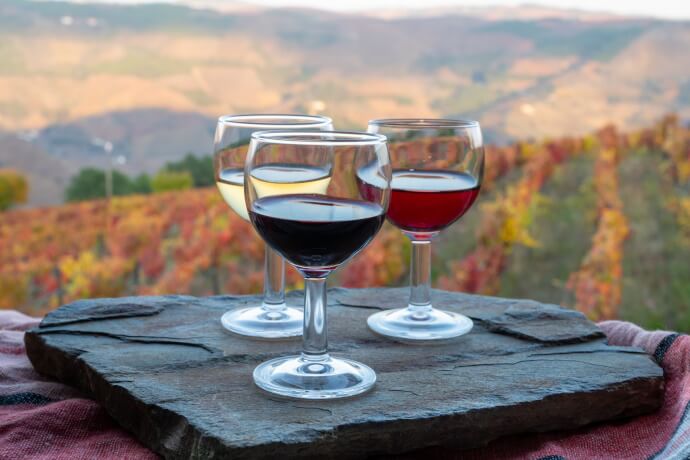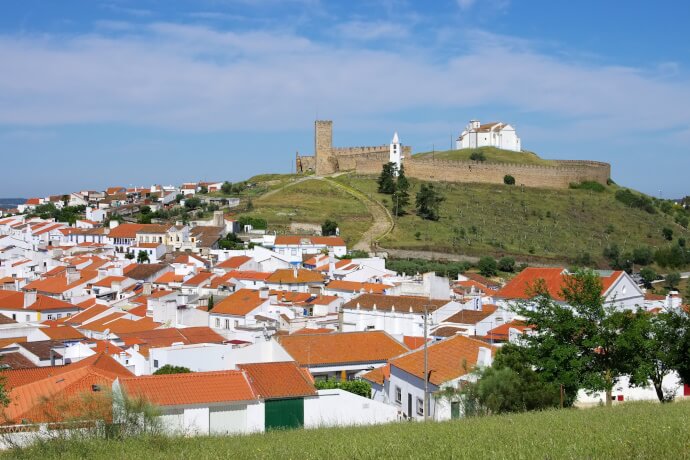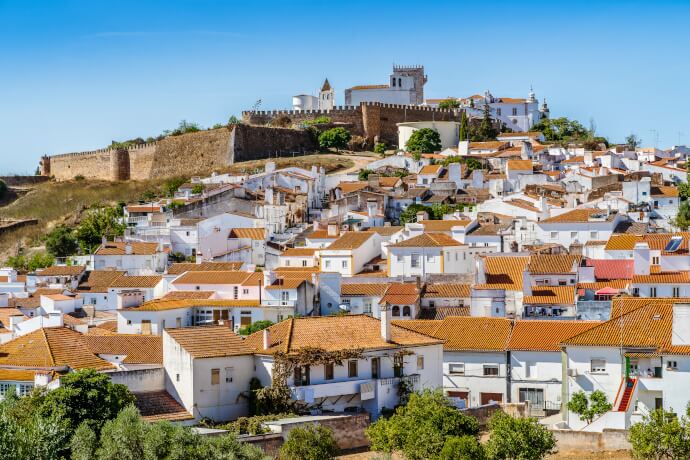Évora is Portugal’s hidden treasure and tourists’ missed adventure. Lisbon, Porto and the Algarve remain the most visited regions in Europe’s westernmost country. However, this charming historical city that combines heritage with culture, mouth-watering gastronomy and compelling architecture is able to make any jaw drop! The truth is, Évora is Portugal’s best-kept secret and the perfect escape from the hustle and bustle of the big cities.
If you want to give a twist to your adventure but still get the same cultural and historical value as in the capital, then today’s post is for you! Learn more about Évora and why you should include this destination in your Portugal tour.
Meet Évora, the capital of Alentejo
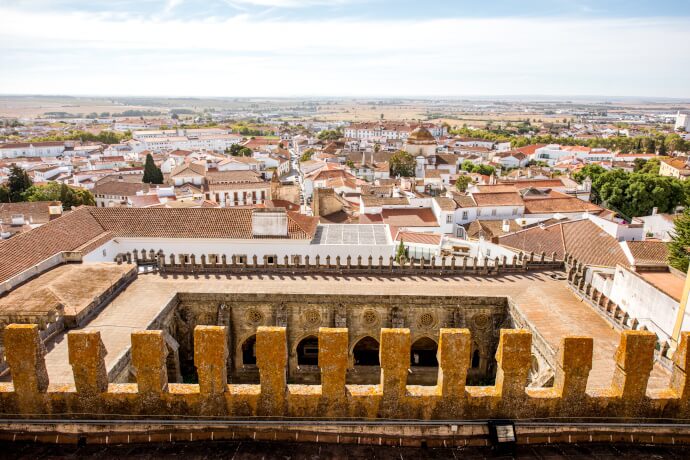
Located right in the heart of Alentejo, Évora is just one hour away from the sunny, vibrant capital city of Lisbon, beyond the Tagus River. This town, also known as a museum city, has lived through the Roman Empire, where it received the honorific designation of Liberalitas Julitas in the 2nd century BC. This period contributed to a significant economic and artistic evolution, which today you can still see in the well-preserved ruins and monuments in the city, such as the Roman Temple and the Roman Baths.
In the 12th century, Évora assumed a central position in the southern region of the Kingdom of Portugal, where it played a vital role as a religious, political and military centre. Still today, you can stroll through this town’s cobblestone streets, narrow alleys and hidden squares characteristic of mediaeval architecture.
Nonetheless, it was in the 1600s that most of the iconic monuments were built. In this period, better known as the city’s “golden century”, Évora University was constructed alongside other monuments of value, like the Silver Water Aqueduct, which contributed to augment the town’s image as a valuable urban centre.
Due to its rich historical heritage, cultural background and eclectic architectural landscape, in 1986 Évora was declared a UNESCO World Heritage Site.
All in all, the reasons to visit this city are endless. From the idyllic plains in the countryside to the historical sites and the flavourful cuisine, we will walk you through the main highlights.
But first…
How to get to Évora
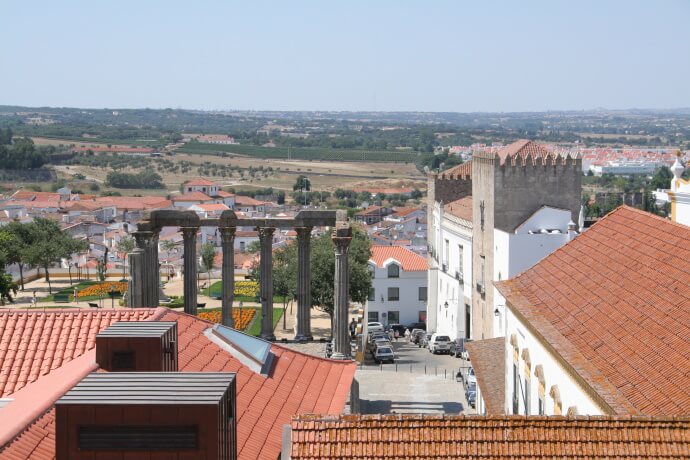
Taking a day trip to Évora or even choosing to stay in the city and the surrounding area for more than one day, you have available to you different travelling options.
For public transportation, you can take the bus or train from Lisbon. This journey normally takes about 1h30 min, leaving you with plenty of time to walk around the city and visit some of its iconic sites upon arrival. Both stations are located a maximum of 20 minutes from Évora’s centre.
Alternatively, you can rent a car in Lisbon and begin your adventure to the South of Portugal. This is a 1h30 min journey as well (depending on the time of day, the duration might vary) where you can follow the A2, A6 and A12 motorways.
Things to do while staying in Évora
Even though Évora is considerably smaller than the likes of Lisbon and Porto, this historical town has an array of different activities, monuments and things for you to do while staying there. So, get ready to set a full day or more to be able to immerse yourself in Évora’s contagious culture and colourful streets.
Here are some of the things to do when in this city:
See the Roman Temple
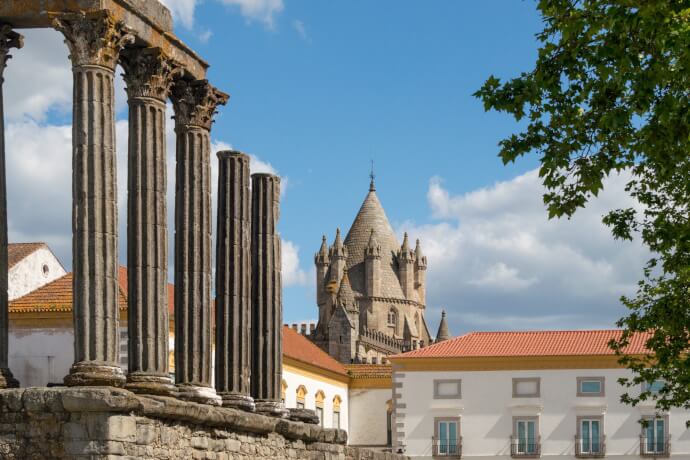
Formerly known as the Diana Temple, this construction in the Conde Vila Flor Square dates back to the 1st century BC during Roman rule. Built in a characteristic Romanesque architecture, the temple was, supposedly, dedicated to the goddess Diana to showcase the emperor’s worship.
In the Arabian, Moorish and mediaeval periods the temple was used for different purposes. Curiously, in the Middle Ages, it served as a market, later turning into a slaughterhouse in the 19th century.
Today, this site is an iconic landmark in Évora, a well-preserved symbol of the Roman Empire and the prosperity this period was known for that you must include in your trip to Portugal!
Visit the Bones Chapel
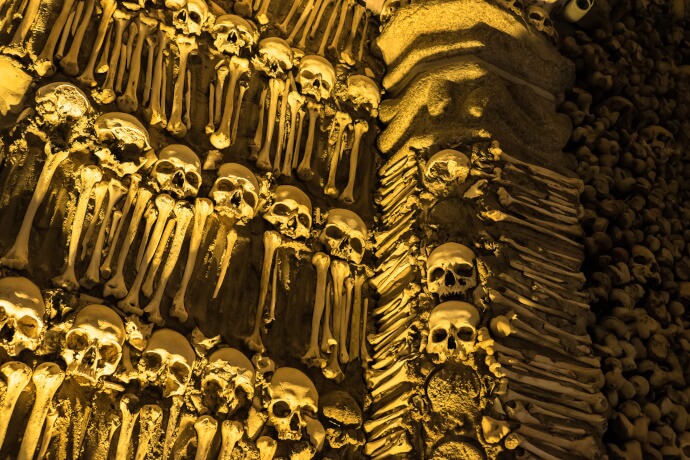
You can find the Bones Chapel inside the Church of St. Francis. It was built in the 16th century by Franciscan monks that inhabited this religious space. The chapel’s walls were stacked with bones, skulls and skeletal remains gathered from the city’s graveyards. Centuries later, this construction remains practically intact.
Before entering this eerie and unique site, you must look up to read the Portuguese inscription above, known by many locals and visitors who have the Bones Chapel on their bucket lists. It reads as follows: “We, the bones that are here, await yours.”
Climb up the Cathedral's towers
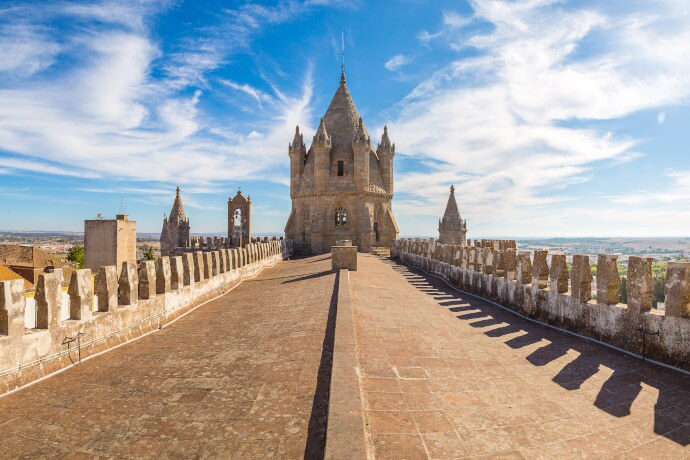
Évora Cathedral is the largest mediaeval cathedral in Portugal. For that reason alone, you must include it in your itinerary!
Called by the locals Sé de Évora, the cathedral is a construction from the 12th century made of granite that depicts the transition from Romantic to Gothic architecture. Later in the 15th and 16th centuries, the church received some reconstruction improvements that were enhanced in the 18th century by the main chapel’s addition, a sponsorship of King João V.
On each side, the Évora Cathedral has two towers you can climb. Up there you can have a beautiful view of the city, its landscape and the peaceful countryside too. This unique experience will give you greater insight into the magnificence of this construction and its beauty.
From the outside, we recommend you pay attention to the dome, as it is considered one of the cathedral’s most mesmerizing architectural features.
Discover Giraldo Square

If you want a place to drink a café or fresh drink and buy souvenirs to bring back home, this is the right place to do it. Giraldo Square is Évora’s main square, which bustles with activity and energy, mostly at the weekends. Here, you can find cafés, shops and restaurants to your liking. Sitting at a table outside, enjoying the sun and the romantic light of a warm end-of-day, you can enjoy and admire the city from a different point of view.
However, it is important to note that Giraldo Square was once a place of terror and fear. This was Spanish Inquisition’s regional execution ground in the 16th and 17th centuries. Still, in this same square, a few centuries earlier, the Portuguese King João II ordered the traitors' decapitation.
A notable construction to pay attention to in this square is the Fonte Henriquina, a water fountain with eight streams representing the eight different streets that stem from this square.
Wander through the streets, forests and farms along the aqueduct
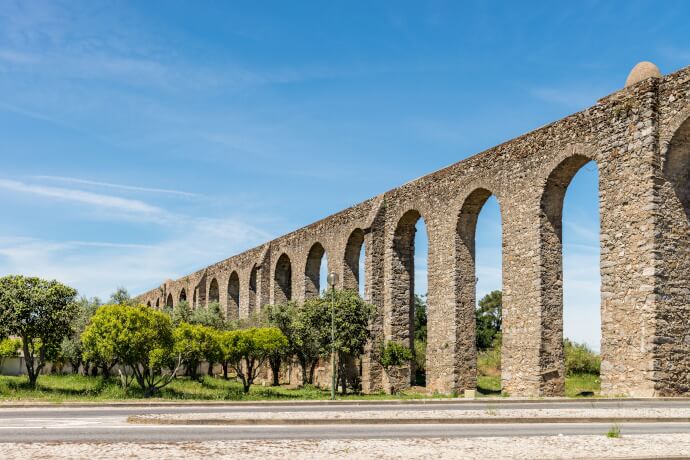
Silver Water Aqueduct is a jaw-dropping monument in Évora that stretches over a distance of 18km. It has been providing water to the city’s population since the 16th century, more precisely, the year 1537, when it was inaugurated in a ceremony that counted with the presence of King João III.
The best way to grasp this construction’s minor details and history is to follow along the aqueduct on the Água de Prata walking or cycling route. This 8.3km itinerary leads you to cork oak forests and farms that offer you a different perspective of the city of Évora, where its natural landscape and the countryside stand out.
If you prefer a shorter route, you can opt to follow the aqueduct from Porta da Lagoa right into the city’s centre. Here you will be able to walk along the mediaeval streets and 16th-century constructions, which will make your journey equally pleasant!
Try local cuisine
If these monuments and historical background are not reason enough for you to visit Évora, then its gastronomy might do the trick!
In this Alentejo region of Portugal, the following dishes will leave your mouth watering. Porco à Alentejana is one of the most popular recipes and it is made of cubed pork, clams, fried potatoes, paprika and fresh coriander. For something sweeter, locals go for the Pão de Rala, a dessert thought to have been invented in the Santa Helena do Monte Calvário Convent. This sweet is a round bread made of an almond-based dough with sugar and sweet egg yolk threads and a jam or purée of gila squash. Other dishes you will find mostly include black pork meat, migas (similar to bread stuffing) and enchidos, common ingredients in the local gastronomy
Buy handmade crafts
Purchasing an item from the places we travel to is common practice among most tourists! When visiting Évora, you surely must do it too. And there is the perfect street for you to buy something for your friends and family.
October 5th Street in Évora is a popular location for people to buy handmade crafts from Évora. Here, you can find several shops that sell some of the most traditional products of the region, mainly textiles, wine, ceramics and cork-made objects.
Already in the 14th and 15th centuries, this place was known to be where commercial exchanges happened. These resulted from the activity of Jewish communities, known as the goldsmiths, and other locals who worked in the leather manufacturing industry.
Explore the surrounding areas
One of Évora’s advantages is its centrality in the Alentejo region and proximity to other villages and towns worth visiting. So, if you rent a car and venture on a trip to this city, we highly recommend you explore the surrounding areas, where you can learn even more about Portuguese culture, history and heritage.
Cromeleque dos Almendres
On the outskirts of Évora, about 20km away, you can visit the ancestral Cromeleque dos Almendres, one of the largest pre-historic monuments in Europe. The Cromlech is composed of a combination of big oval boulders that will remind you of giant eggs standing on the ground in a circle. Data and research have shown that these rock formations date back 7,000 years!
The Almendres Cromlech, AKA the “Portuguese Stonehenge”, is more likely to have served as a site for astronomical observation and sacred rituals, which took place during sunrise or in the summer solstice. On the site, you can equally observe in detail human-like figures and drawings carved on the monoliths.
This site is quite easy to reach if you follow the N114 road, which will take you about 30 minutes to get there. Plus, you will find a car parking area on site, in close proximity to the monument.
Visit a wine-producing estate
One of the strongest suits of the Alentejo is its wines! So, while in the region, you are in the right location to visit local wineries.
Inside and outside the walls of Évora, there are wine-tasting tours available where you can learn more in detail about the field-to-bottle process of this particular industry. We recommend you the Herdade da Cartuxa and Quinta Amoreira da Torre. In these experiences you have first-hand insight into the wine-producing techniques and traditions of the region.
Get to know Arraiolos
Also known as the “rug village”, Arraiolos is a quaint town with a rich and long historical heritage, heightened by its peculiar Romantic-Gothic circular castle. This town has been inhabited since the 4th Millenia BC. In 1305, King Dinis ordered the construction of this castle and changed his address there.
This town is best known for the famous Tapetes de Arraiolos, hand-embroidered rugs. The tradition we know today dates back to the 15th and 18th centuries when the flower motifs dictated the peak and popularity of this tradition in the kingdom. This particular type of rug resulted from an abundance of raw materials, such as wool, looms and skilled artisans who lived in the area.
Still in Arraiolos, you should visit the historical centre, the Matriz de Arraiolos Church, and the beautiful countryside painted with cork oak forests and idyllic plains.
Explore Estremoz
Driving up into the northeastern region of the Alentejo, you will stumble upon the charming Estremoz. This village, about 47km away from Évora, is known as one of the “white cities” due to the white houses spread across the whole expansion of the hill. Its relation with the colour white also stems from the deposit of marble in the region. This in particular has made Estremoz a village known in all corners of the world.
If you are looking for more historical sites to explore, you must visit the Estremoz Castle and its towers of the three crowns, home to royals over time, including King Dinis and Holy Queen Isabel. The Bicas Fountain, Nossa Senhora dos Mártires Chapel and Concregados Convent are equally worth a visit.
At the end of the day, enjoy a relaxed meal at a traditional restaurant to try the lamb stew, ensopado de Borrego, and pork’s feet with coriander, pezinhos de coentrada.
A historical journey to remember
Lost in the heart of Alentejo, Évora is a hidden gem which has been off tourists’ radar for too long. With a rich historical background, a strong cultural heritage and delicious gastronomy, this town is the perfect escape from the popular Lisbon, Porto and the Algarve. Staying here is to embark on a historical journey you will remember for the time to come. In this small town in southern Portugal, you can have an immersive experience that will give you a well-rounded understanding of the country’s culture and traditions. Are you ready to start planning your trip to Portugal?





